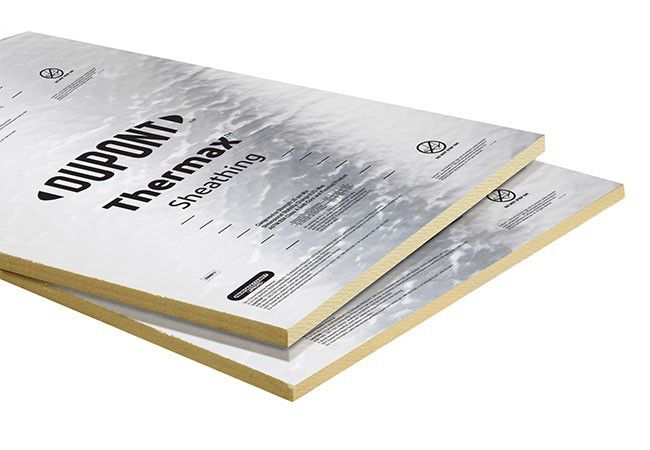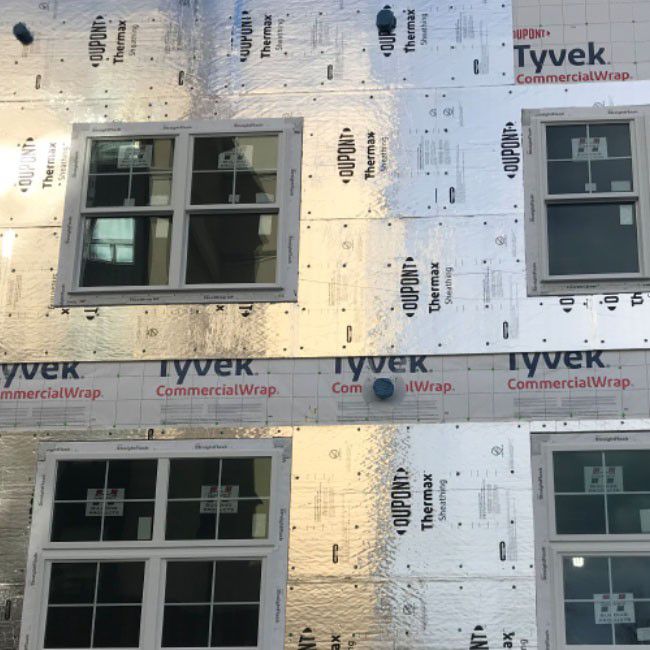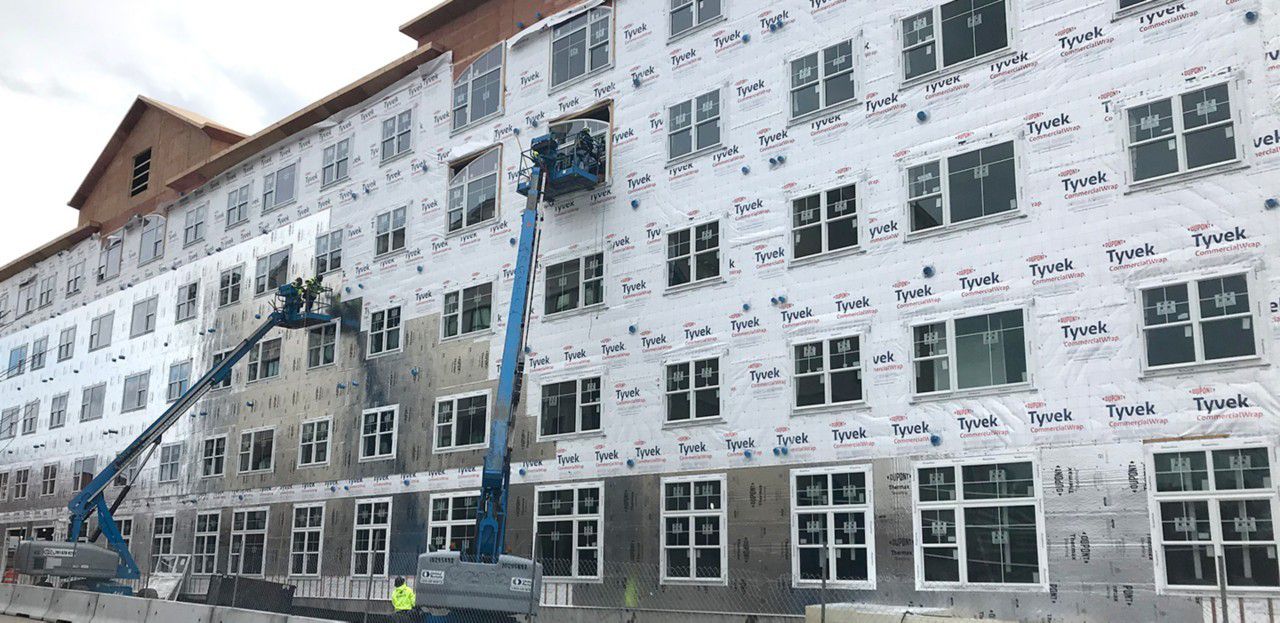DuPont™ Thermax™ Sheathing Insulation
Nonstructural, Glass-Fiber-Infused Rigid Polyiso Insulation



DuPont™ Thermax™ Sheathing Insulation
Nonstructural, Glass-Fiber-Infused Rigid Polyiso Insulation
Features & Benefits
Specifications
Standard Sizes
| Thickness | Width | Length | R-Value | Edge Treatment |
|---|---|---|---|---|
| 1/2 in. | 4 ft. | 8 ft. | 3.3 | Square Edge |
| 3/4 in. | 4 ft. | 8 ft. | 5.0 | Square Edge |
| 1.0 in. | 4 ft. | 8 ft. | 6.8 | Square Edge |
| 1 1/2 in. | 4 ft. | 8 ft. | 9.8 | Square Edge, Shiplap |
| 2.0 in. | 4 ft. | 8 ft. | 13.0 | Square Edge, Shiplap |
| 2 1/2 in. | 4 ft. | 8 ft. | 15.8 | Square Edge, Shiplap |
| 3.0 in. | 4 ft. | 8 ft. | 18.6 | Square Edge, Shiplap |
| 3 1/2 in. | 4 ft. | 8 ft. | 21.3 | Square Edge, Shiplap |
| 4.0 in. | 4 ft. | 8 ft. | 24.0 | Square Edge, Shiplap |
Note: Please be advised that additional sizes may be available. Availability of all sizes varies by region and is subject to change. For further information, please contact your local DuPont Sales Representative or call us at 1-866-338-7668.
Testing
<b>Thermax™ Sheathing Insulation</b> exhibits the properties and characteristics indicated in the table below when tested as represented. Review all instructions and (Material) Safety Data Sheet ((M)SDS) before use. Please contact DuPont at 1-833-338-7668 when additional guidance is required for writing specifications that include this product.
| TEST METHOD | TEST TITLE | PROPERTY | RESULTS |
|---|---|---|---|
| FIRE | |||
| UL 723 | Test Method for Surface Burning Characteristics of Building Materials | Surface Burning Characteristics1 | Flame Spread ≤ 25 Smoke Developed ≤ 450 Core and Finished Product |
| NFPA 285 | Standard Fire Test Method for Evaluation of Fire Propagation Characteristics of Exterior Wall Assemblies Containing Combustible Components | Fire Progagation - Exterior2 | Pass |
| UL 1715 | Standard for Safety Fire Test of Interior Finish Material | Fire Progagation - Interior | Pass |
| NFPA 286 | Standard Methods of Fire Tests for Evaluating Contribution of Wall and Ceiling Interior Finish to Room Fire Growth | Fire Progagation - Interior | Pass |
| NFPA 268 | Standard Test Method for Determining Ignitability of Exterior Wall Assemblies Using a Radiant Heat Energy Source | Ignitabiilty - Exterior | Pass |
| THERMAL | |||
| ASTM C518 | Standard Test Method for Steady-State Thermal Transmission Properties by Means of the Heat Flow Meter Apparatus | Thermal Resistance 1 inch @ 75°F mean temp3 | 6.9 ft2 •h•°F/Btu, R-value, min. |
| ASTM D2126 | Standard Test Method for Response of Rigid Cellular Plastics to Thermal and Humid Aging | Dimensional Stability | 0.2% linear (length & width) |
| STRENGTH | |||
| ASTM D1621 | Standard Test Method for Compressive Properties of Rigid Cellular Plastics | Compressive Strength4 | 25 psi |
| ASTM C203 | Standard Test Methods for Breaking Load and Flexural Properties of Block-Type Thermal Insulation | Flexural Strength | 75 psi |
| ASTM D1623 | Standard Test Method for Tensile and Tensile Adhesion Properties of Rigid Cellular Plastics | Tensile Strength | 500 psf, min. |
| AIR | |||
| ASTM E2178 | Standard Test Method for Determining Air Leakage Rate and Calculation of Air Permeance of Building Materials | Rate of Leakage | <0.001 L/s*m2, max |
| ASTM E2357 | Standard Test Method for Determining Air Leakage Rate of Air Barrier Assemblies | Air Leakage | No Leakage |
| ASTM E283 | Standard Test Method for Determining Rate of Air Leakage Through Exterior Windows, Skylights, Curtain Walls, and Doors Under Specified Pressure Differences Across the Specimen | Rate of Leakage | <0.02 L/s*m2, max |
| WATER | |||
| ASTM E96 | Standard Test Methods for Gravimetric Determination of Water Vapor Transmission Rate of Materials | Water Vapor Permeance. | 0.01 perm |
| ASTM C209 | Standard Test Methods for Cellulosic Fiber Insulating Board | Water Absorption | 0.1% volume, max. |
| ASTM E331 | Standard Test Method for Water Penetration of Exterior Windows, Skylights, Doors, and Curtain Walls by Uniform Static Air Pressure Difference | Water Penetration | Pass |
1Calculated flammability values for this or any other material are not intended to represent hazards that may be present under actual fire conditions.
2See Jensen Hughes engineering judgement
3R-value of 1.0-inch of foam measured @ 75°F mean temperature, determined in accordance with ASTM C518 after aging for 90 days @ 140°F.
4Vertical compressive strength is measured at 10 percent deformation or at yield, whichever occurs first.
Code Compliance
<b>Thermax™ Sheathing Insulation</b> complies with the following codes:
| Code | Description |
|---|---|
| US Product Listings & Verifications | ASTM C1289 - Type I, Class 2<br>2021, 2018, 2015, 2012, and 2009 International Residential Code (IRC)<br>2021, 2018, 2015, 2012, and 2009 International Building Code (IBC)<br>2021, 2018, 2015, 2012, 2009 International Energy Conservation Code (IECC) )<br>2021, 2018, 2015, 2012 International Green Construction Code (IGCC)<br>Thermax™ products are covered under Underwriters Laboratories Inc. (UL) File R5622)<br>UL 723 - Surface Burning Characteristics)<br>UL 1256 - Fire Test of Roof Deck Constructions Nos. 99, 120 and, 123)<br>UL 263 - The following designs are 1, 2, 3 or 4 hour wall rated assemblies as listed in the UL Fire Resistance Directory: U026, U326, U330, U354, U355, U424, U425, U460, U902, U904, U905, U906, U907, V321, V322, V454, V482, V499, W404, W307, W413, W417, and W444)<br>FM 4880 - Wall Construction Metal-Faced – Class 1 Fire Rated to Max. 30’ Exposure High, 3” Thick, 4’ Wide, When Installed asDescribed in the Current Edition of FMRC Approval Guide. Contact Dupont Technical Support for most current FM 4880 attachment requirements. |
| Regional Code Listings & Reports | Miami-Dade County Florida - NOA-No. 22-0119.02 - Expiration Date July 1, 2027<br>2022 California Green Standards Code<br>California Bureau of Household Goods And Services Directory of Certified Insulation Materials - T 1534 |
| US Code Reports | Intertek CCRR-0435<br>DrJ TER 1506-03 |
